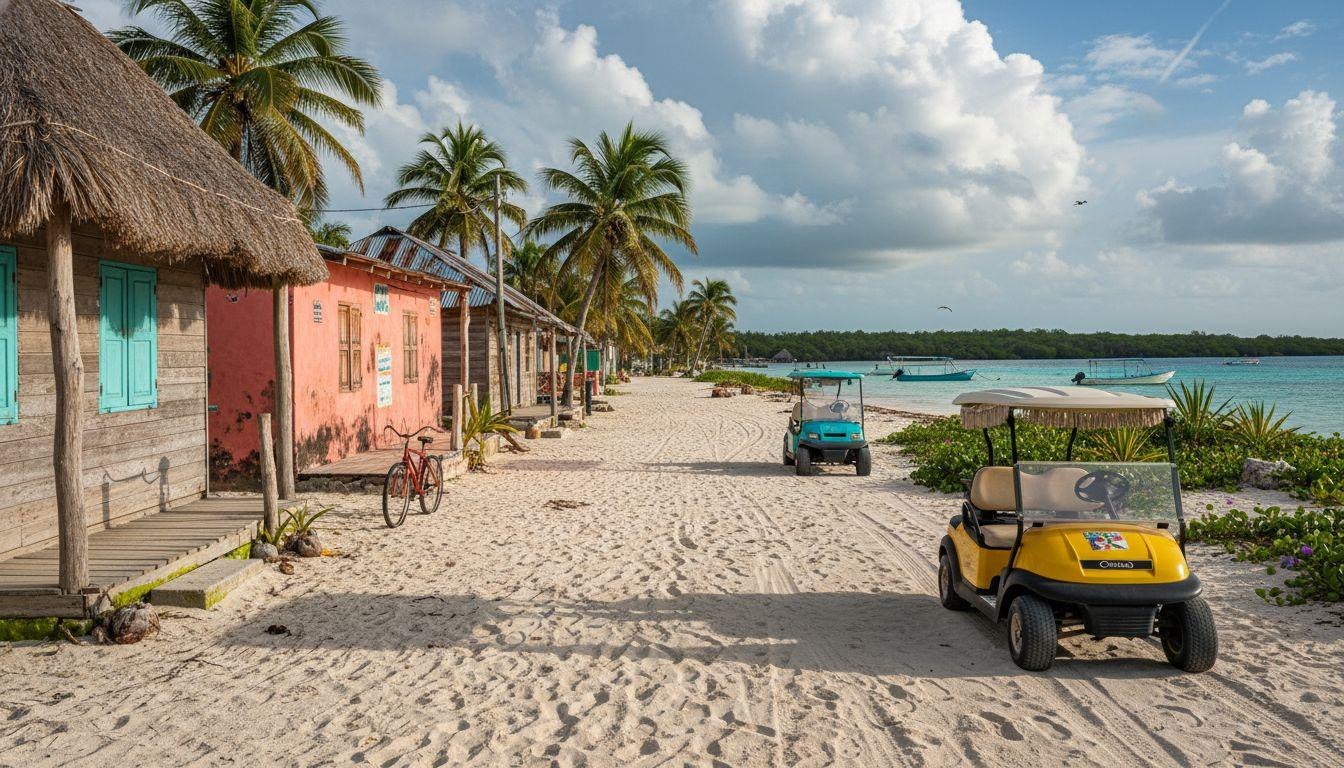Twenty minutes from Mexico’s mainland, turquoise waters lap against powder-white beaches where golf carts replace traffic and bioluminescence replaces neon lights. Isla Holbox stretches 26 miles of car-free paradise, yet costs half of what travelers pay in overcrowded Cancún. While 3 million tourists flood the Riviera Maya’s concrete resorts, this fishing village of 2,000 residents preserves authentic Caribbean culture at prices that haven’t forgotten the peso’s value.
The journey tells the story. ADO buses depart Cancún every two hours for Chiquilá port ($18 USD, 2.5 hours). Then comes the 20-minute ferry crossing ($17 USD) where pelicans guide wooden boats across Yalahau Lagoon. No cruise ships dock here. No tour buses queue at dawn.
Why Cancún lost its affordable soul
Cancún’s Hotel Zone stretches 14 miles of high-rise concrete blocking Caribbean views. Average hotel rates hit $340 per night before $40 resort fees. Playa Delfines charges $25 parking. Restaurant meals average $45 in tourist zones.
Three million annual visitors create bottlenecks everywhere. Chichén Itzá day trips pack 500 tourists per bus. Beach loungers cost $35 daily at Playa Tortugas. Spring break transforms beaches into human parking lots.
Infrastructure excellence remains Cancún’s strength: reliable WiFi, English menus, predictable resort experiences. But authentic Mexico vanished beneath development decades ago.
Meet Holbox: where less costs less and delivers more
Car-free Caribbean authenticity at Mexican prices
No paved roads exist on Holbox, only white sand streets. No cars navigate the island, just golf carts ($5-15 USD rides), bicycles ($12 daily rental), and bare feet. Maximum building height stays at two stories, preserving palm grove skylines.
Playa Holbox runs one mile of pristine sand meeting shallow turquoise water. Depth stays waist-high 50 meters offshore, creating safe swimming even during high tide. Over-water hammocks line the shore, built from local wood over crystal-clear shallows.
Accommodation comparison reveals dramatic savings: budget rooms cost $60-100 nightly (versus $180-250 in Cancún), mid-range hotels run $120-180 (versus $280-420), luxury villas reach $250-350 (versus $450-600). This village of 650 where Aegean turquoise meets golden stone shares similar authentic appeal but different geography.
Real prices from real places
Local restaurant meals cost $8-18 per person for fresh seafood. Lobster tacos run $12 at beachside stands. Three-course dinners with wine reach $25-35 maximum. Morning fish markets sell directly from boats: red snapper $8 per pound, lobster $15 per pound.
Activities deliver better value too. Whale shark tours cost $95-110 (June through September season) versus $180-220 from Cancún operators. Three-island excursions run $55-75 for full-day trips including Isla Pájaros bird sanctuary and Yalahau cenote.
What authentic Mexico actually feels like
Nature that Cancún’s development destroyed
Bioluminescence transforms May through October nights into living magic. Kayak tours ($35-45) paddle through mangrove lagoons where every stroke ignites blue-green plankton light. New moon periods produce strongest glowing effects, creating underwater galaxies.
Whale shark season brings Earth’s largest fish to feeding grounds 30% closer than Isla Mujeres departure points. Better than Bora Bora, this 1,190 island archipelago offers similar marine encounters at fraction of typical costs.
Punta Mosquito nature reserve guards the northern tip via 15-minute bike rides from town. Wild flamingos, 150+ bird species, and untouched beaches stretch across protected mangroves. Zero entrance fees apply.
Island culture before Instagram
Morning fish markets operate 6-8 AM when boats return with overnight catches. Locals prep seafood for lunch service using no industrial supply chains. Families bike to dinner while street dogs nap in doorways. Conversations happen primarily in Spanish.
Traditional fishing supports 35% of local employment despite tourism growth. Seven turquoise lagoons across El Nido preserve similar authentic island culture across different geography. Evening town squares transform into community gathering spaces without manufactured entertainment.
Planning your escape from resort tourism
Getting there requires intention but rewards patience. Most travelers fly into Cancún International Airport, then choose ADO buses ($18 USD, 3 hours to Chiquilá) or private transfers ($85-120 USD, 2.5 hours direct). Ferry schedules run every 30-60 minutes, 6 AM through 9 PM daily.
Best timing spans November through April for dry season weather (75-85°F, minimal rain). Bioluminescence peaks during May-October rainy months, worth the trade-off for nature enthusiasts. Forget San Andrés, this Colombian island offers similar UNESCO-protected Caribbean experiences for budget-conscious travelers.
On-island transportation stays simple: walking covers most needs, bike rentals ($10-15 daily) reach Punta Mosquito reserve, golf cart rentals ($45-65 daily) prove unnecessary unless traveling with elderly or small children.
Your questions about Isla Holbox answered
How much should I budget for a week in Holbox versus Cancún?
Budget travelers spend $450-650 weekly in Holbox (accommodation, meals, activities) versus $850-1,200 in Cancún. Mid-range budgets run $750-950 in Holbox versus $1,400-1,800 in Cancún. Luxury experiences cost $1,200-1,600 in Holbox versus $2,200-2,800 in Cancún hotel zones.
What makes Holbox more authentic than other Mexican beach destinations?
Car-free policy preserves traditional island pace while 2,000 year-round residents maintain fishing industry alongside tourism. UNESCO Biosphere Reserve status limits development density. Local families still operate most restaurants and guesthouses, keeping profits within the community rather than international resort chains.
Is Holbox too remote or underdeveloped for comfortable travel?
Modern amenities exist without overwhelming infrastructure: reliable WiFi in hotels, ATMs in town center, English-speaking staff at tourism businesses. Medical clinic operates daily with helicopter evacuation available. Credit cards work at 80% of establishments, though carrying $200-300 USD cash recommended for smaller vendors and golf cart taxis.
Dawn breaks over Holbox as fishing boats return with silver catches, their wooden hulls cutting turquoise water while pelicans dive nearby. The island awakens to authentic Caribbean rhythms that Cancún lost decades ago. Here, paradise costs half the price because it never forgot its value.
